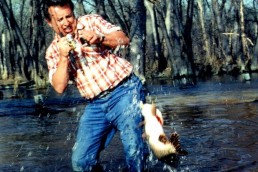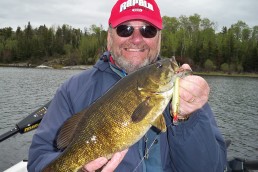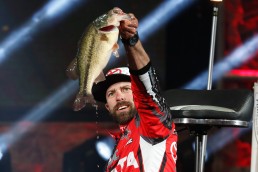My Way to Wade Rivers and City Lakes
SHARE THIS POST
Those who wade rivers do it wrong 80 percent of the time. This mistake is entering the river above the targeted area they intend to fish. Why you say? Let me explain.
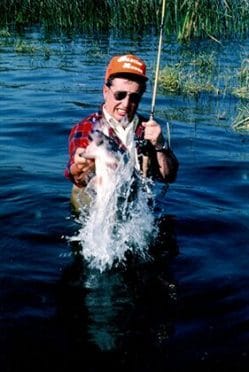
Scaring up silt
The biggest mistake is to enter the river and work your way downstream. That’s wrong!
As you walk downstream, all the silt you kick up goes ahead of you. This may not bother the small fish you’re after, but it will make any big ones leery.
Sounding the alarm
Sound travels well in water. It goes ahead of you, notifying the fish you’re coming.
Poor presentation
Lure presentation is all wrong. Most of, or all of, your retrieves are upstream. The opposite way river fish receive their food. Food, for the most part, comes with the current. In many cases, when retrieving upstream, you fail to get your bait to the bottom, missing the Benthic Zones, where the rivers larger fish hold up. This is especially true when crank baiting. While attempting to cast to the edges of the river your presentation will be swept away downstream, never reaching your intended target.
Unintentional dips
As you reach a deep hole, after stepping downstream, you make the final mistake of placing your forward foot into the forward slope of the hole. Current forces you forward, and you take a bath. This bath, though possibly needed, flushes all the fish in the hole. Even if you don’t have much current at your back, this can be a calamity in many ways.
Summer wading secrets
I’ve found that wading during the summer, when it’s warm, is best done in white tennis shoes and a pair of blue jeans. If you need a fish holder, pick up a rough potato sack and a nylon fish stringer. Then, lace the nylon stringer in and out through the open part of the bag. Tie this very efficient fish carrier to a belt loop and you’re in business. Once this burlap bag gets wet, it will keep fish alive all day. I sound cheap, but, after 75 years of working rivers, I’ve found no better way to carry fish when you’re wading.
Now, let’s start you off right. Enter the river, stream or creek downstream from the targeted area you want to fish. Walk upstream. All silt and sound will go downstream, behind you, as you walk upstream.
As you cast upstream and retrieve downstream, you accomplish a proper lure or bait presentation. Remember, fish food comes to them from upstream. This upstream, downstream presentation gets your bait down close to bottom. Thus, entering the Benthic Zone as you retrieve. As you cast to either side, your bait, or crankbait will travel with the current, get down near bottom and not be pulled away from the projected target area you intended to travel.
Then—possibly the most important thing—as you step into the back end of a hole, water pressure is on the front of you. Whether it be your legs or water up to your waist, it will save you from slipping and taking a bath. In rivers, it’s very important to imitate the natural food presentation which comes with the current.
Holes in the rivers hold most of the larger fish. By standing at the back of a river hole directly at midstream, the angler can cover most of the hole by casting up at its beginning and retrieving your choice of lures or baits down through it.
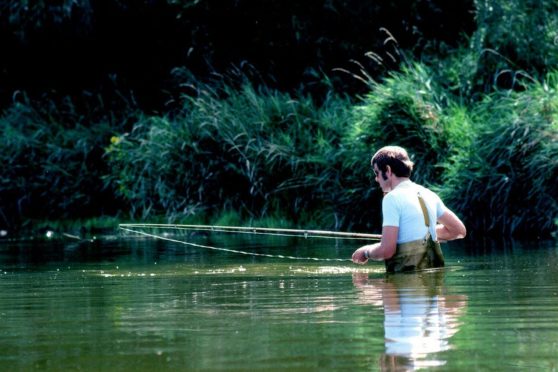
The exception
Live baiting in river holes may be done from the top side. If you are using a sucker or a bait walker rig to work the hole with worms or live minnows, work your way around the hole using a walking stick to test the depth at the holes edge. Once on the top side, station yourself on either side. Plant your footing and don’t move more than is necessary. Make your first live bait cuts at the top of the hole.
Are you enjoying this post?
You can be among the first to get the latest info on where to go, what to use and how to use it!
Then, work your back towards the back end. If the river or creek has walleyes and bass, the bass will be at the upstream side of the hole. Walleyes will be at the back end. If it’s trout you’re after, the large trout will be staying near the front of the hole early in the morning and late in the evening. Smaller trout will be along either side.
Timber brings in fish
In smaller creeks or rivers, I’ve found timber, not lures, will attract google eyes as well as bluegills. These can be worked by moving in on them by water or on shore. Work a vertical-holding jig such as a 1/16-ounce black or crawfish-colored Ugly Bug or a simple black hair jig with an artificial worm tail. Often the fallen timber structures have created an undercut hole. That hole will hold other species, such as catfish and smallmouth bass. See diagram. In most cases, the panfish will stay downstream from the timber. If you take one rock bass, there’ll be a lot more. You may have to work for them by sling shooting your jig back inside the hole created by the fallen tree. Tipping your jig with a bit of worm for scent will help.
Bank holes are often found on small streams—especially those running through farmland. Look for them where current runs hard into the bank where the stream curves on a bend. To work these holes, you can get to the fish under them by casting toward the top of a suspected hole and letting your lure run with the current under the bank. Such holes can be really productive, at times.
Wade upstream, fish upstream
Remember, always begin your wading downstream from the area you intend to work. Go into the current as you work the stream or river.
As long as we’re talking about wading, lets talk about wading your local lakes. Years ago, when I was working the tackle counter in a local sporting goods store in metro Minneapolis, I had the chance to host Bill Binkelman on a jaunt to a local lake. You guessed it, I got Old Bill to do a little wading in a local lake surrounded by homes. We started at a little before 6 a.m. while the hordes of traffic were zipping by on a freeway which divided the lake in two. Bill had taught me so much, I felt the need to give away one of my secrets.
We began by entering the lake at the boat landing. No one was there. The hotrod bass boaters wouldn’t be there for another three hours. I put Bill in the lead as I instructed to get waist deep on the outside of the weeds. That would position him about 40 feet off the edge of the weeds. As normal, he was using a single nightcrawler hooked by the head. One number five split shot was pinched on his line 18 inches up from his hook. I would use an old lure we once made called a Hairy Worm.
It was the first jig and pig to hit the bass market. The Hairy Worm consisted of a plain hair jig tied on a vertically flat head with a worm tail sticking out the back. I was using a 1/8-ounce size. Gapen’s continued to produce this lure until the imports from China beat us up on price. Bill Binkelman of Outdoor Life magazine and the Indianapolis Store made it famous in a 1/16-ounce size, which he used for rock bass. Bill’s gone now and so is the Hairy Worm, but it sure caught the hell out of Indiana Google Eyes.
Hitting the weeds with Bill
I let Bill lead off, suggesting he work the open pockets in the shoreline weeds. I followed up with my all-black weapon. Within a block, we had nine largemouths landed—three of them to Bill. At that time, eating bass was okay.
“Gapen, we could have done this in a boat, you know” came Bill’s comment as he released his fourth fish. I acknowledged his comment and returned an answer. “But, Bill, it wouldn’t have been near as much fun. This way, we’re sneaking up on them in a way they wouldn’t have suspected.”
As I hit an unusually large bass he’d missed with his nightcrawler, I laughed and pointed to the city buildings around us. By now, all the gang in suits and ties were zipping by us. Some even honked or waved as I jerked a 7- pound largemouth to surface. Bill said something about a black hairy worm he wasn’t using.
We fished on for a couple more hours, always on the outside of the shore weeds, working them slowly and with the finesse only Bill possessed. I forgot how many bass we took, but my dear friend had enough bass, and pike to go home with to make up several meals. Bill did do one thing that I failed to do. He caught two huge bluegills and a fat Rock bass. I caught the two pike, one an 8-pounder. All were taken in a small lake situated in the central region of Minneapolis. That was long ago. The lake is gone now, covered up with an office complex.
The best way to hit city slicker fish
Even so, there’s a lesson in that day with Bill. If you want to catch fish in your city lakes, try wading.
Oh yes, Bill and I did it in blue jeans and white tennis shoes. The shoes weren’t as white when we finished, but we sure had fun.
So, readers, I challenge you to give your local lake a go. Try wading them. If the water is too deep, it won’t be at the edge of the weeds. Walk along, cast ahead of yourself and catch a bass or two as you think about the old mentor Bill Binkleman, and the River Rat, Dan Gapen Sr.
MWO
SHARE THIS POST
Did you enjoy this post?
You can be among the first to get the latest info on where to go, what to use and how to use it!
Dan Gapen
Considered one of the world’s leading river anglers, Dan Gapen, Sr. has shared his knowledge with MidWest Outdoors readers and viewers for more than 40 years. He is a member of all three Fishing Halls of Fame—International, National Freshwater, and Minnesota. He has an immense grasp of the world’s fisheries. He may be contacted at 877-623-2099.
@TheGapenCompany.
